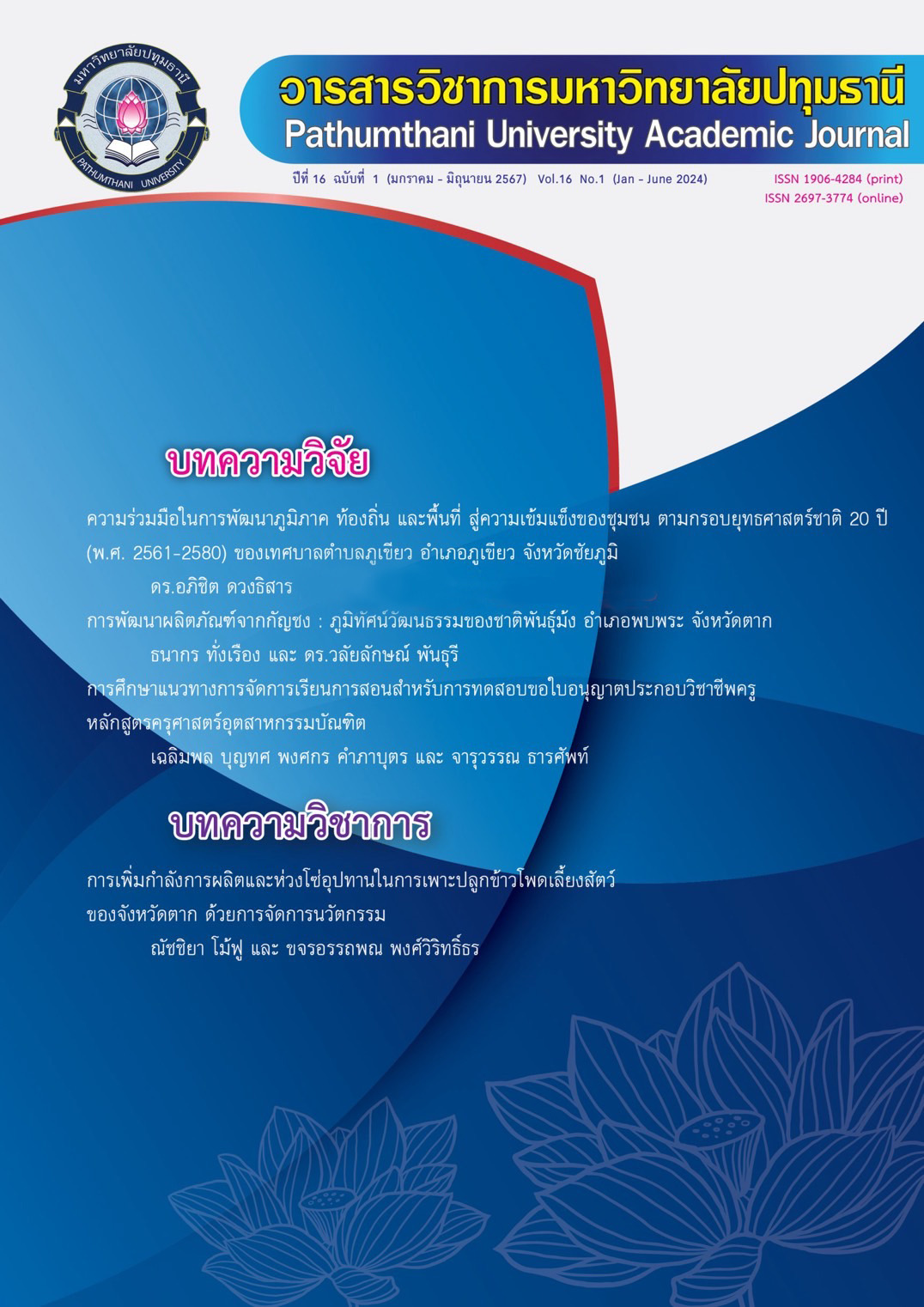THE GUIDELINE MODEL FOR THE LIFE INSURANCE BUSINESS
Keywords:
Model, Guidelines, Life Insurance BusinessAbstract
The objective of this research is to scrutinize the attitudes and behaviors of individuals toward the operational framework of the life insurance industry in Sa Kaeo Province, aiming to propose a model for augmenting life insurance business operations in the area. The research sample comprises residents aged 25 years and older from Sa Kaeo Province, totaling 400 individuals, alongside insights from 5 experts in the life insurance domain. Research instruments employed encompassed a questionnaire gauging attitudes toward life insurance purchasing behavior and perspectives on the industry's operational structure, in addition to semi-structured interviews delving into practices within the life insurance sector. Quantitative data analysis was executed utilizing pre-existing software to scrutinize frequencies, percentages, averages, and standard deviations, while qualitative data underwent content analysis.
Key findings from the research included:
- Life Insurance Purchasing Behavior: A predominant proportion of respondents favored investing in life insurance. The principal motive behind procuring life insurance was to utilize it as capital for long-term medical treatment and post-death management planning. Respondents often opted for life insurance policies that piqued their interest and aligned with their requirements, particularly when grappling with insecurities in their daily lives or employment. Life insurance agents assumed a pivotal role in furnishing information and swaying purchase decisions. Family members emerged as the most frequent purchasers of life insurance, with insurance premiums predominantly remitted via banks, corporations, and agents.
- Public Sentiments Regarding the Life Insurance Business Model: Overall, sentiments regarding the life insurance business model in Sa Kaeo Province were rated highly. Aspects such as protection and life insurance returns garnered the highest ratings, trailed by tax deductions, the proficiency of life insurance agents, and favorable attitudes toward life insurance.
- Recommendations for Enhancing the Life Insurance Business Model: To foster positive sentiments toward life insurance, companies ought to undertake initiatives to communicate the significance of life insurance, devise manuals for lucrative life insurance savings, and concentrate on efficacious advertising and promotional endeavors. Concerning the proficiency of life insurance agents, training programs should underscore the importance of life insurance and the imperative nature of its acquisition. Agents should dispense balanced information to clients and exude expertise and sincerity during transactions. Manuals elucidating life insurance sales strategies should be crafted for new recruits. In relation to protection and life insurance returns, companies should equip employees with adeptness in explicating the sales mechanism effectively, categorizing life insurance variants, and meticulously overseeing and evaluating the performance of life insurance agents. With regard to tax deductions, companies should furnish clientele with a compendium of tax deductions predicated on premium ratings, train agents on various tax deduction types, and lucidly articulate sales promotion models and standards for life insurance services and premium rates, inclusive of return particulars and stipulations.
References
ทัศนีย์ ศรีกัลยา. (2554). ความคิดเห็นของผู้บริโภคในเขตกรุงเทพมหานครที่มีผลต่อการทำประกันชีวิต. กรุงเทพมหานคร. บริหารธุรกิจมหาบัณฑิต สาขาวิชาการจัดการการเงินและการธนาคาร มหาวิทยาลัยรามคำแหง.
บุญชม ศรีสะอาด. (2535). หลักการวิจัยเบื้องต้น. (พิมพ์ครั้งที่ 3). กรุงเทพมหานคร : สุวีริยาสาสน์.
ศิริโรจน์ วงศ์กระจ่าง. (2554). ศึกษาในเรื่องปัจจัยที่มีผลต่อการตัดสินใจทาประกันชีวิตของข้าราชการในเขตอำเภอแม่แจ่ม จังหวัดเชียงใหม่. สารนิพนธ์ปริญญา, หลักสูตรเศรษฐศาสตรมหาบัณฑิต สาขาวิชาเศรษฐศาสตร์ธุรกิจ. มหาวิทยาลัยเชียงใหม่.
กรมการประกันภัย. (2560). การประกันชีวิต. [ออนไลน์]. เข้าถึงได้จาก : http://www.oic.or.th/th/consumer/. เมื่อวันที่13 มกราคม 2566.
สำนักงานประชาสัมพันธ์จังหวัดสระแก้ว. (2556). ผู้ว่าราชการจังหวัดสระแก้วเปิดงานวันประกันชีวิตแห่งชาติ. [ออนไลน์]. เข้าถึงได้จาก http://pr.prd.go.th/tak/ewt_news. php?nid =975&filename=younew. เมื่อวันที่ 13 มกราคม 2566.
อดุลย์ จาตุรงคกุล. (2550). พฤติกรรมผู้บริโภค. (พิมพ์ครั้งที่ 2). กรุงเทพมหานคร : มหาวิทยาลัยธรรมศาสตร์.
O’Keefe & Berger. (1997). Self-management for college students: The ABC approach. New York: Partridge Hill.
Schiffman & Kanuk. (1994). Consumer Behavior. Upper Saddle River, NJ: Pretice-Hall.
Watson. (1976). Behavior: An introduction to comparative behavior. New York: McGraw-Hill.
Downloads
Published
How to Cite
Issue
Section
License
Copyright (c) 2024 ขจรอรรถพณ พงศ์วิริทธิ์ธร

This work is licensed under a Creative Commons Attribution-NonCommercial-NoDerivatives 4.0 International License.
บทความที่ได้รับการตีพิมพ์เป็นลิขสิทธิ์ของวารสารมหาวิทยาลัยปทุมธานี
ข้อความที่ปรากฎในบทความแต่ละเรื่อง เป็นความคิดเห็นส่วนตัวของผู้เขียน กองบรรณาธิการไม่จำเป็นต้องเห็นด้วยเสมอไป และไม่มีส่วนรับผิดชอบใด ๆ ถือเป็นความรับผิดชอบของผู้เขียนแต่เพียงผู้เดียว



